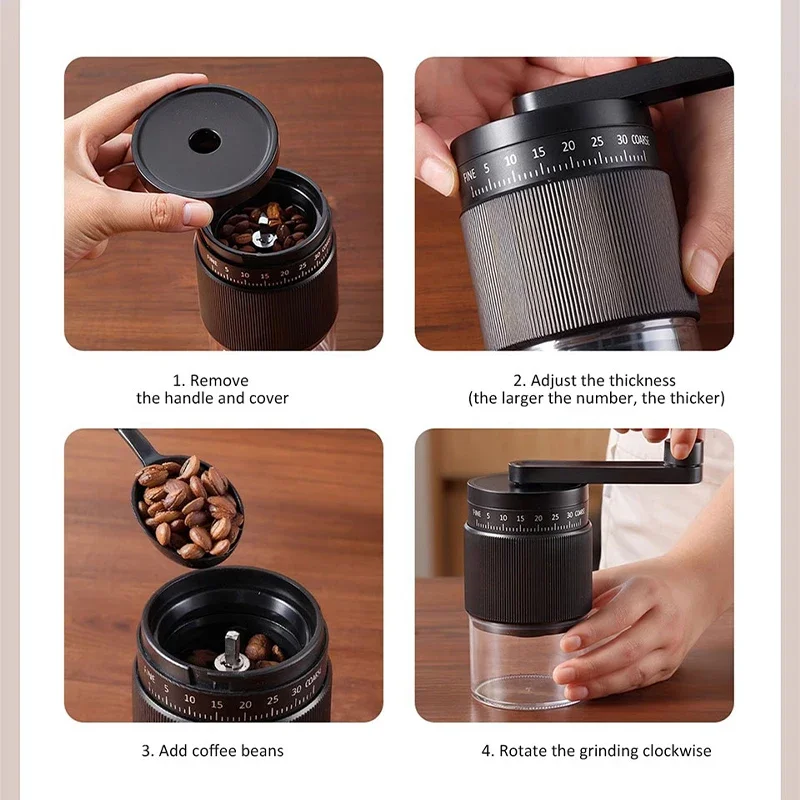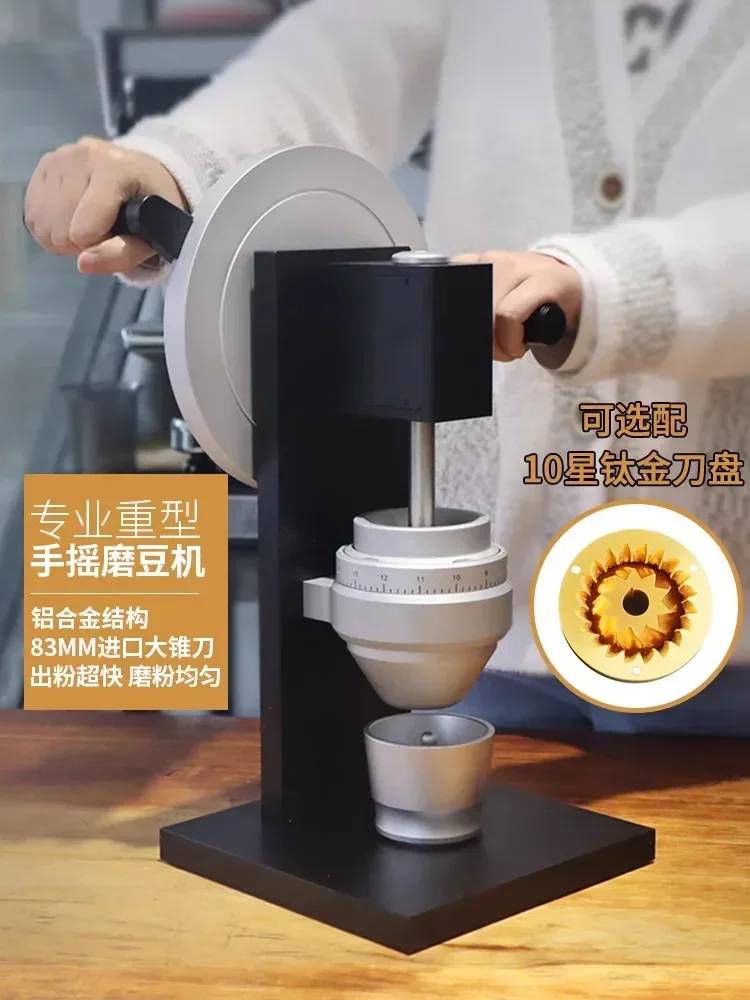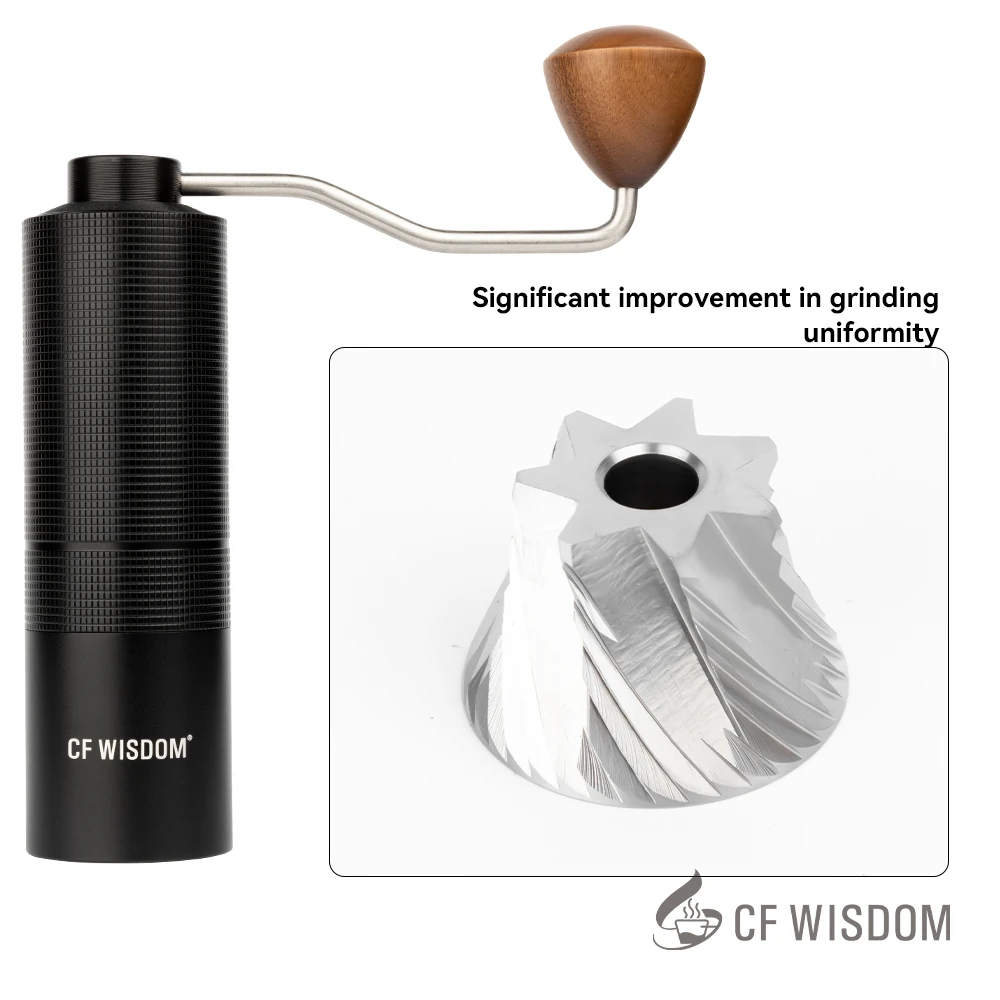Why Grind Size Makes or Breaks Your Espresso
The perfect espresso shot balances on a knife-edge, with grind size playing the deciding role between disappointment and delight. When water under high pressure (typically 9 bars) meets coffee grounds, it extracts flavors in a matter of seconds – usually just 25-30 seconds. This brief encounter makes grind size absolutely critical.
Why does grind size matter so much for espresso? It’s all about surface area. Finer grounds create more surface area for water to interact with, increasing extraction efficiency. When your grind size is off, even by a small margin, the results can be dramatic:
- Too fine: Water struggles to flow through, over-extracting bitter compounds
- Too coarse: Water rushes through too quickly, under-extracting and creating sour shots
The relationship between grind size and flavor is so fundamental that many experienced baristas consider fine-tuning espresso grind size the single most important variable in espresso preparation. While other brewing methods can be somewhat forgiving, espresso magnifies every small adjustment, especially when dealing with different roast levels.
Understanding how grind size affects flavor profiles creates the foundation for consistently excellent espresso. The interaction between water, pressure, and coffee particles follows predictable patterns – once you know what to look for.
The Science Behind Coffee Roasting Levels
Coffee beans undergo remarkable physical and chemical transformations during roasting. These changes directly impact how we should grind them for optimal extraction.
Light roasts maintain much of the bean’s original character. Roasted just until the first “crack” occurs (around 385-410°F or 196-210°C internally), these beans are dense, hard, and contain more moisture. Their cell structure remains largely intact, with minimal oils on the surface. Light roasts typically lose only 3-5% of their weight during roasting.
Dark roasts, by contrast, undergo more dramatic changes. Roasted well beyond the second “crack” (430-450°F or 221-232°C internally), these beans become significantly less dense, more brittle, and develop oils on their surface. Their cellular structure breaks down considerably, and they lose 15-20% of their original weight.
These physical differences create distinct extraction patterns:
| Characteristic | Light Roast | Dark Roast |
|---|---|---|
| Density | Higher | Lower |
| Solubility | Lower | Higher |
| Cell Structure | More intact | More degraded |
| Surface Texture | Dry | Oily |
| Extraction Speed | Slower | Faster |
These fundamental differences explain why you need different grind settings for different roast levels. The right precision manual grinder can help you navigate these variations with accuracy and consistency.
Light Roast Beans: Why They Need a Finer Grind
Light roast beans present unique challenges for espresso extraction. Their physical and chemical properties directly influence the optimal grind size needed for balanced shots.
These beans maintain much of their original density and hardness, making them naturally resistant to water penetration. Their cellular structure remains largely intact, creating fewer pathways for water to access extractable compounds. Additionally, light roasts have:
- Higher density (typically 15-20% denser than dark roasts)
- Lower solubility due to less developed sugars and oils
- Less porosity and surface fracturing
- More acids and fewer caramelized compounds
These characteristics mean water struggles to dissolve and extract flavors from light roasts in the brief 25-30 second espresso window. To compensate for this resistance, a perfect espresso grind size for light roasts must be noticeably finer than for dark roasts.
The finer grind creates more surface area and more resistance to water flow, extending contact time and ensuring proper extraction of the bright, complex notes light roasts are known for. Without this finer grind, light roast espresso often tastes sour, thin, and underdeveloped – failing to showcase the delicate flavor nuances these beans can offer.
Dark Roast Beans: Why They Require a Coarser Grind
Dark roast beans stand in stark contrast to their lighter counterparts. The extended roasting process fundamentally alters their structure in ways that significantly impact grinding requirements.
Through prolonged heat exposure, dark roasts develop:
- Reduced density (becoming 15-20% less dense than light roasts)
- Brittle, more porous bean structure
- Oils on the surface (increasing with roast level)
- Higher solubility due to broken down cell walls
- More developed sugars and caramelized compounds
These physical changes make dark roast compounds much more accessible to water. The broken cell structures, increased porosity, and higher solubility allow for faster, more efficient extraction – sometimes too efficient for espresso’s brief extraction window.
Using a grind that’s too fine with dark roasts typically leads to over-extraction, producing espresso that tastes bitter, harsh, and lacks the rich, sweet characteristics these beans can provide. A fine-adjustment hand grinder with precise settings helps achieve the slightly coarser grind that dark roasts require.
The ideal dark roast grind still needs to be espresso-fine (much finer than for drip coffee), but noticeably coarser than for light roasts. This coarser setting creates the perfect resistance level, allowing water to extract the deep, chocolatey notes and full body without pulling out excessive bitter compounds.
Visual Guide: Identifying the Right Grind Size
Visually assessing your grind can provide helpful guidance when dialing in different roast levels. For light roasts, aim for a texture similar to fine table salt or powdered sugar – the particles should feel very fine between your fingers with almost no detectable grit. When you pinch this grind, it should clump somewhat readily.
For dark roasts, the ideal espresso grind looks closer to granulated sugar (still very fine, but with just barely perceptible individual particles). When you rub these grounds between your fingers, you’ll feel slight texture compared to the light roast grind. This difference might seem subtle, but it significantly impacts how coffee grind affects pressure and flow during extraction.
A practical visual test: Place a small amount of ground coffee on a white sheet of paper and spread it thinly with your finger. Light roast grounds should look like a nearly uniform powder, while dark roast grounds might show just barely distinguishable particles when looking very closely.
Remember that visual assessment is just a starting point – taste and flow rate will ultimately guide your adjustments. The slight difference between suitable light and dark roast grinds might be just 2-3 clicks on a quality grinder, but this small adjustment makes a world of difference in your cup.

Dialing In: Step-by-Step Process for Light Roasts
Achieving optimal extraction with light roasts requires methodical adjustment and attention to detail. Follow these steps to dial in your light roast espresso:
Start finer than you think necessary: Begin with a very fine grind – slightly finer than you’d typically use for espresso. Light roasts need this extra fineness to slow extraction and enhance flavor development.
Use an appropriate dose: For light roasts, try a slightly higher dose than standard – approximately 18-20g in a double basket (if your basket can accommodate it). This provides more coffee for water to interact with.
Set your target parameters: Aim for a 1:2 to 1:2.5 brew ratio (e.g., 18g coffee yielding 36-45g espresso) with a longer extraction time of 28-35 seconds.
Pull a shot and evaluate: Watch the flow rate carefully. The initial drops should appear around 8-10 seconds after starting the shot, with a slow, steady stream developing.
Taste and adjust: If the shot tastes sour or watery, your grind is too coarse – go finer. If the shot barely drips or tastes bitter/harsh, your grind is too fine – go coarser.
Optimize temperature: Light roasts benefit from higher brewing temperatures (94-96°C/201-205°F) to help extract their dense structure.
Quality manual coffee grinders for espresso provide the precision needed for these fine adjustments. Make small, incremental changes between shots – sometimes just a single adjustment click can transform your extraction.
Remember that well-extracted light roast espresso typically features bright acidity, floral or fruit notes, and a clean, vibrant finish. The shot may appear lighter in color with a thinner crema compared to dark roasts – this is perfectly normal and desirable for light roast espresso.
Dialing In: Step-by-Step Process for Dark Roasts
Dark roasts require a different approach to dial in properly. Their increased solubility and brittle structure demand careful grind adjustments to prevent over-extraction. Follow these steps for perfect dark roast espresso:
Start with a moderately fine grind: Begin slightly coarser than you would for light roasts – still firmly in espresso territory, but not at your grinder’s finest setting.
Adjust your dose: Standard or slightly lower doses work well for dark roasts – typically 16-18g in a double basket. This helps prevent over-extraction of the highly soluble beans.
Set your target parameters: Aim for a slightly shorter brew ratio of 1:1.5 to 1:2 (e.g., 18g coffee yielding 27-36g espresso) with a slightly shorter extraction time of 22-28 seconds.
Pull a shot and evaluate: The initial drops should appear within 5-7 seconds, developing into a steady stream. Watch for proper flow – too fast indicates a coarser grind is needed; too slow means go slightly finer.
Taste and adjust: Dark roasts should produce rich, full-bodied espresso with sweet, chocolatey notes. If you taste ash or intense bitterness, your grind is too fine. If the shot lacks body or tastes sour/sharp, go finer.
Lower the temperature: Dark roasts extract more easily at slightly lower temperatures (88-92°C/190-198°F) to prevent harsh over-extraction.
Adjusting grind size for optimal shot timing is particularly important with dark roasts, as their extraction window is narrower. Make smaller adjustments than you would with light roasts – sometimes half a step on your grinder is sufficient to transform the shot.
Well-extracted dark roast espresso displays a thick, tiger-striped crema, full body, and sweet, caramelized flavors with minimal bitterness. The lower acidity and increased sweetness should create a smooth, satisfying experience.
Troubleshooting Common Extraction Problems
Even experienced baristas encounter extraction issues when working with different roast levels. Here’s how to identify and solve the most common problems:
Under-extraction (Particularly Common with Light Roasts)
– Symptoms: Sour, sharp taste; watery mouthfeel; shot runs too quickly (under 20 seconds)
– Solution: Grind finer, increase dose slightly, ensure proper distribution, consider increasing temperature
Over-extraction (Particularly Common with Dark Roasts)
– Symptoms: Bitter, harsh, ashy taste; shot runs too slowly (over 35 seconds)
– Solution: Grind coarser, decrease dose slightly, lower brewing temperature
Channeling Issues
– Symptoms: Uneven extraction with both sour and bitter notes; “gushing” sections in the stream; visible holes in the puck after brewing
– Solution: Improve distribution technique, ensure level tamping, check for clumping in the grounds, use a distribution tool
Inconsistent Shots
– Symptoms: Extraction quality varies significantly between shots despite using the same settings
– Solution: Check grinder for retention issues, ensure consistent dosing, examine for grinder burr alignment problems
Poor Crema Quality
– For Light Roasts: Thin or minimal crema is normal; excessive expectations may lead to over-extraction
– For Dark Roasts: Excessive dark crema may indicate over-extraction; patchy crema suggests channeling
For comprehensive solutions to these and other extraction challenges, exploring detailed troubleshooting guides for espresso grind issues can provide valuable insights tailored to your specific equipment.

Beyond Grind Size: Other Factors That Impact Extraction
While grind size is fundamental, several other variables interact with it to determine extraction quality:
Dose Adjustments
The amount of coffee used significantly impacts extraction. Light roasts often benefit from slightly higher doses (18-20g) to provide more material for extraction and balance acidity. Dark roasts may perform better with standard or slightly lower doses (16-18g) to prevent over-extraction of their highly soluble compounds.
Temperature Considerations
Temperature dramatically affects extraction efficiency. Light roasts need higher temperatures (94-96°C/201-205°F) to break down their dense structure. Dark roasts extract more readily at lower temperatures (88-92°C/190-198°F), which helps control bitterness.
Pressure Profiling
If your machine allows pressure adjustment, light roasts often benefit from longer pre-infusion (5-10 seconds) at lower pressure to saturate the dense grounds before full pressure is applied. Dark roasts may perform better with shorter pre-infusion and gentle pressure ramping to prevent extracting harsh compounds.
Distribution and Tamping
Even distribution becomes increasingly important with light roasts, as their resistance to water makes them prone to channeling. Dark roasts require consistent, careful tamping to create even resistance despite their more brittle structure.
Bean Age and Freshness
As beans age, they generally require a finer grind to achieve the same flow rate. This effect is more pronounced with dark roasts due to their higher oil content and continued degassing. For optimal results, refer to the ultimate espresso grind size chart that accounts for both roast level and bean age.
Fine Adjustment Hand Grinder, Precision Manual Grinder, Travel Coffee Grinder
Price range: $185.11 through $494.63 Select options This product has multiple variants. The options may be chosen on the product pageHand Burr Grinder, Hand Crank Coffee Grinder, Manual Espresso Grinder, Portable Coffee Grinder
Price range: $262.72 through $300.22 Select options This product has multiple variants. The options may be chosen on the product pageHand Burr Grinder, Manual Coffee Grinder Stainless Steel, Precision Manual Grinder
Price range: $183.64 through $187.52 Select options This product has multiple variants. The options may be chosen on the product pageManual Coffee Grinder Stainless Steel, Manual Espresso Grinder, Travel Coffee Grinder
Price range: $276.22 through $276.39 Select options This product has multiple variants. The options may be chosen on the product pageHand Crank Coffee Grinder, Manual Coffee Grinder for Espresso, Manual Coffee Grinder Stainless Steel
$349.15 Select options This product has multiple variants. The options may be chosen on the product page
Choosing the Right Grinder for Precise Espresso
The quality of your grinder directly impacts your ability to navigate the different grinding requirements of various roast levels. For espresso, particularly when switching between light and dark roasts, certain grinder features become essential:
Grind consistency is paramount – even slightly uneven particle distribution can cause channeling and unbalanced extraction. Quality burr grinders create uniform particles, while blade grinders produce inconsistent results that make espresso preparation nearly impossible.
For working with different roast levels, look for grinders with:
- Stepless adjustment or micro-stepped settings to make tiny, precise changes
- Quality burrs (ceramic or steel) that produce consistent particle size
- Minimal retention to prevent cross-contamination between different beans
- Stability and alignment for consistent results over time
The difference between success and frustration often comes down to adjustment precision. When switching between light and dark roasts, you need a grinder that can make the small, incremental changes required. Our manual espresso grinders are specifically designed to provide this level of precision and consistency.
How to Switch Between Roast Levels Efficiently
Moving between different roast levels requires methodical adjustment to avoid wasted beans and frustration. Follow these steps for efficient transitions:
Record your settings: Keep notes of successful grind settings for each bean variety and roast level. This provides a reliable starting point when returning to a familiar bean.
Purge thoroughly: When switching between roasts, run 5-10 grams of the new beans through the grinder to clear any retained grounds from the previous roast.
Make larger initial adjustments: When moving from light to dark, start by making a significant coarsening adjustment (perhaps 3-4 clicks or notches), then fine-tune as needed.
Expect time differences: Dark roasts typically extract 3-5 seconds faster than light roasts at equivalent grind settings. Factor this into your initial adjustments.
Recalibrate temperature: Remember to adjust your brewing temperature when switching roast levels.
Precision grind adjustment techniques help baristas make these transitions smoothly. With practice, you’ll develop an intuitive sense for how much to adjust when switching between specific beans in your regular rotation.
Are There Exceptions to the Light-Fine/Dark-Coarse Rule?
While the light-fine/dark-coarse principle holds true in most cases, coffee’s complexity means there are occasional exceptions:
What about medium roasts?
Medium roasts generally require a grind size between light and dark recommendations. However, some medium roasts behave more like light roasts, while others extract more like dark roasts. Let taste be your guide rather than appearance alone.
Can bean origin affect optimal grind size?
Absolutely. Some high-density beans from specific regions (particularly high-altitude African coffees) might need an even finer grind despite their roast level. Conversely, some lower-density beans might extract more efficiently at slightly coarser settings.
Do processing methods impact grinding requirements?
Yes. Natural/dry processed coffees often extract more readily than washed/wet processed coffees at the same roast level, sometimes requiring slightly coarser grinds. Honey/pulped natural processes fall somewhere in between.
What about aged beans?
Aged beans (particularly aged Sumatra or similar varieties) may break the typical pattern due to their unique cellular structure and moisture content. These specialty beans often require experimentation regardless of roast level.
For exploring these exceptions, having quality espresso coffee hand grinders with precise adjustment capabilities allows you to fine-tune your approach based on each coffee’s unique characteristics rather than relying solely on roast level.
Will Different Espresso Machines Require Different Grinds?
Different espresso machines can significantly impact the optimal grind size for any roast level:
Pressure Variations
Machines operating at different pressures require grind adjustments. Traditional 9-bar machines need a specific range, while lower pressure machines (like some lever espresso makers at 6-8 bars) typically require slightly finer grinds for equivalent extraction.
Basket Design
Basket shape, depth, and hole pattern dramatically affect flow rate. Precision baskets with evenly distributed holes allow for finer grinds, while basic baskets with fewer holes may require slightly coarser grinds to prevent choking.
Temperature Stability
Machines with superior temperature stability can extract more efficiently from light roasts without overextracting dark roasts. Less stable machines may require grind compensations to achieve balance.
Manual vs. Semi-Automatic vs. Fully Automatic
Manual lever machines often work best with slightly coarser grinds due to their pressure profiles, while automatic machines with programmed pre-infusion may allow for finer grinds with light roasts.
Mastering grinder adjustments for your specific machine involves understanding its unique characteristics and how they interact with different roast levels. The key is developing a consistent approach to adjusting your grind when changing beans or roast profiles, always letting taste be your ultimate guide.







